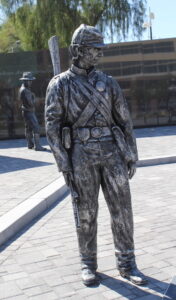Nevada State Veterans Memorial – Civil War Soldier
las vegas, nv
Discription:
Statue 7.5” tall, made of aluminum-magnesium alloy. The image of the Civil War soldier is a testament to those who were tempered in the fires of a conflict that tore the nation apart at its seams. The stance of the soldier suggests obedience to his cause, which in part meant keeping the union of states together. His head is turned away, perhaps looking toward the next battlefield, or perhaps to a future where all battles have been fought and the wounds of a nation are healed. The artist is quoted as saying he designed all the figures to appear as though they are looking through time.
Responcible Organization/Individual:
Las Vegas Veterans Memorial Foundation.
Designed By:
Douwe Blumberg, sculptor

Address:
555 E. Washington Ave, Las Vegas, Nevada 89101.
GPS Coordinates:
Hours Available
Ceremonies: yes
History:
The idea for a memorial was initially broached by American Shooters, Inc. under the direction of President and Board Chairman Mick Catron. He is an Army Green Beret veteran. His company formed a foundation and approached the Las Vegas City Council for permission to begin seeking a site and raise charitable funds. He was aided by Scott Tiano, executive director of the foundation. Tiano is a veteran of the U.S. Marine Corps. A nationwide competition was conducted amongst artists who submitted their concepts to the foundation. In addition, various Las Vegas locations were scouted before settling on the current State-owned two-acre site.
The United States Civil War was a conflict that pushed the nation to the brink of destruction. The war would pit the largely agrarian society of the South against the more industrialized states of the North. The existence or abolition of slavery, the power of a central government and the future of the young nation would be decided upon the fields of the war. From 1861 to 1865 more than three million Americans would soldier, from the riverbanks of the Mississippi to the swamps of the Carolinas, to the wheat fields of Pennsylvania. Prior to the war, many of these men had never ventured beyond the valleys and cities they called home. In four years of bloody conflict, they would come to know home as a place they hoped and prayed to see once again. By the time Confederate General Robert E. Lee’s surrender at Appomattox Court House in April of 1865 brought an end to the war, more than 600,000 Americans had lost their lives in the hostilities. The difficult process of reconstruction following the war would lay the foundations of what has developed to become a truly united, United States of America.